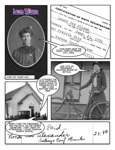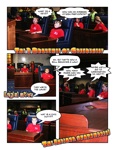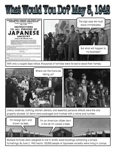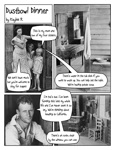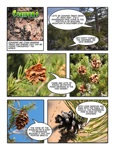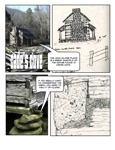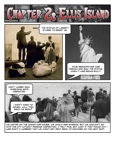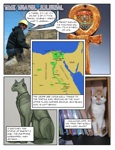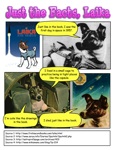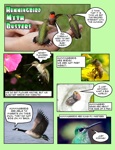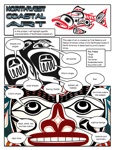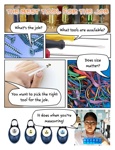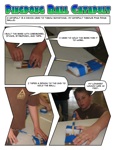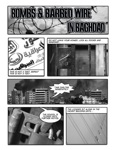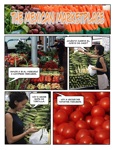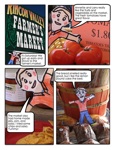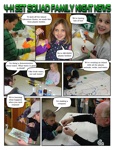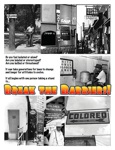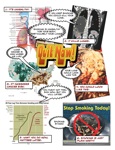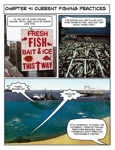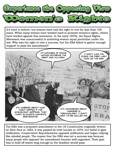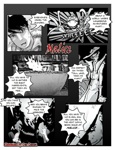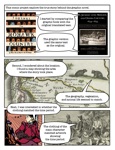Projects that Pop: The Mission Matters

Building fluid environments for learning involves developing instructional materials, activities, and assessments that meet the needs of all learners.
Whether you and your students use Comic Life, PowerPoint, Moviemaker, or Google Presentations, it's time to re-imagine our student assignments and assessments. Identifying a meaningful mission, infusing engaging examples, and offering opportunities to participate and extending the experience through technology-rich resources are critical to project pizazz.
PowerPoint can be seductive. Young people and teachers alike are susceptible to it's charms. Small groups can be heard saying:
- Let's do a PowerPoint Presentation!
- Let's animate the clip art.
- Let's add a few bullet points.
- How about some crashing glass.
Rarely do we hear students or educators talking about the purpose of the presentation, the quality of the information presented, or opportunities to extend the experience beyond the presentation. These are the elements that make a presentation powerful... not clipart and annoying sounds.
- Meaninful Mission: World Press Photos - Award winning photos
- Engaging Examples: Test Flight
- Offering Opportunities: Good Reads - Ship Breaker by Paolo Bacigalupi
You can download a short PowerPoint presentation that provides an overview for your students and teachers. In the past, presentations often displayed factual information as a series of bullet points. Increasingly, skillful presenters are shifting their attention from disseminating facts to designing experiences that address the diverse needs of their audience and the many channels of communication available for conveying ideas. Don't let new technology get in the way of high level thinking. A Prezi project isn't more powerful than a PowerPoint project. It's the content that makes the difference.
Student projects are about content not PowerPoint, explore tools for creating project materials:
- Software-based
- Microsoft PowerPoint
- Apple's Keynote
- Open Source Tools
- Comic Life
- Window Moviemaker
- Cloud-based
- Slideshare
- Glogster
- Google Presentation
- Prezi - interactive presentations
- Voicethread
Rather than exploring PowerPoint, let's explore how to think differently about presenting ideas, representing ideas, and extending the experience. For instance, thinking about the structure of animals through the use of X-ray images by Nick Veasey from National Geographic.
Let's explore projects, collaborations, and reflection.
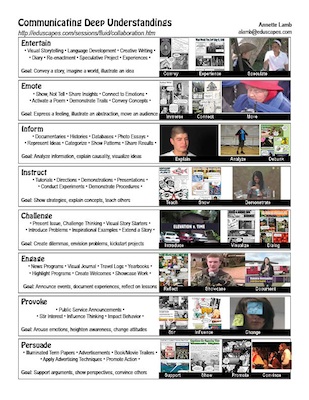 Eight Effective
Eight Effective
Project Missions
Rather than individuals or teams simply creating reports, comics, movies, or presentations, refocus the activity on a specific category of deep understanding.
The comic examples were created using Comic Life and in some cases online software.
Click the image on the right to see it full-size.
Explore eight missions: Entertain, Emote, Inform, Instruct,Challenge, Engage, Provoke, and Persuade.
Entertain
• Visual Storytelling • Language Development • Creative Writing • Diary • Re-enactment • Speculative Project • Experiences •
Goal: Convey a story, imagine a world, illustrate an idea
Watch Somewhere over Web 2.0 from Wizard of Apps: The Musical.
- Middle School Examples
- Based on a true story, Minutemen: YouTube
- Bernajean Porter's DigiTales website contains lots of stories.
- Re-enact History: The Package (Vimeo). Based on D-Day time period.
- Speculative: The 254 Year Old Boy. An African-American high school student meets a Revolutionary War soldier.
- Teacher Examples
- Music Videos: Science Rapper on YouTube. Check out Edgar Allan Poe Takes on Cancer, Sweet Primary Sources
Explore some comic examples:
Emote
• Show, Not Tell • Share Insights • Connect to Emotions • Activate a Poem • Demonstrate Traits • Convey Concepts •
Goal: Express a feeling, illustrate an abstraction, move an audience
Explore movie making examples:
- All Ages
- Middle School Examples
- High School Examples
- Activate Poem: Timed Thought
Explore some comic examples:
Inform
• Documentaries • Histories • Databases • Photo Essays • Represent Ideas • Categorize • Show Patterns • Share Results •
Goal: Analyze information, explain causality, visualize ideas
Explore movie making examples:
- Middle School Examples
- Documentaries: The Life of a Type 1 Diabetic (Grade 7-8), My Journey with Celiac Disease (Grade 7-8),Documentaries: Vimeo, Concussions in Youth Football: Vimeo
- High School Examples
- Documentaries: Camp Purple, To Kill a Mockingbird: Then and Now (Grade 9-12), Road to Redemption (Grade 9-12), The Elastic Tree
Explore some comic examples:
Instruct
• Tutorials • Directions • Demonstrations • Presentations • Conduct Experiments • Demonstrate Procedures •
Goal: Show strategies, explain concepts, teach others
Watch how teens are Using the Flip Video in a High School Math Class (YouTube): Part 1 and Part 2. Addpipecleaners (Youtube) for some fun with graphs.
Explore movie making examples:
- Middle School Examples
- Tutorials: How to Play Drums (Grade 7-8), How to Make Ice Tea (Grade 7-8), How to Ride a Bike Safely (Grade 7-8)
- High School Examples
- Tutorials: How to Drive a Stick Shift (Grade 9-12), How to Make Slime (Grade 9-12), The Scientific Method (Grade 9-12)
- Strategies: NeverBurn
Explore some comic examples:
Challenge
• Present Issue, Challenge Thinking • Visual Story Starters • Introduce Problems • Inspirational Examples • Extend a Story •
Goal: Create dilemmas, envision problems, kickstart projects
Explore movie making examples:
- Middle School Examples
- High School Examples
- Story Problems: Graphing Stories from Dan Meyer for a great math example.
- Watch How to Make a Math Project winner of the CSTMF.
- Conflicts: Watch middle school conflict scenes at Vimeo. These each end with a question about what you think will happen next.
Explore some comic examples:
Engage
• News Programs • Visual Journal • Travel Logs • Yearbooks • Highlight Programs • Create Welcomes • Showcase Work •
Goal: Announce events, document experiences, reflect on lessons
Explore movie making examples:
- Middle School Examples
- News Programs: First Things 1st 2011, First Things 1st 2010, MMS News
- Student Showcase: Tina Siao Portfolio.
- School Program: Feel the Burn. Students explain their physical education program.
- High School Examples
- News Programs: Wolfpack TV, Music is Fun, NTV Morning News
- Topical News: Green Club (YouTube)
- Special Events: Fifth Star from Adobe Youth focusing on the one hundred years of women's right to vote. Notice how interviews, historical photos and footage, and personal narratives are incorporated, Step Up Youth Summit
- Teacher Examples
- Where's Boomer: Teacher-produced project for ELL using Comic Life: Vimeo
- Reflections: Beyond Anne Frank, Bungie Barbie, Monach Butterfly Life Cycle, Stand Up and Speak Out
Explore some comic examples:
Provoke
• Public Service Announcements • Stir Interest • Influence Thinking • Impact Behavior •
Goal: Arouse emotions, heighten awareness, change attitudes
Explore movie making examples:
- Middle School Examples
- PSAs: Smoking Claymation (Grade 7-8), Don't Smoke (Grade 7-8), No Vote, No Voice (Grade 7-8)
- High School Examples
- PSAs: Unearthing Hope, Don't Be a Gutter Ball, 5210, Repercussion, Don't Suicide, Health Pass, Throw Out the Habit (Grade 9-12), Second Hand Smoke (Grade 9-12), A Fairy Tale (Grade 9-12), Testing while Driving (Grade 9-12),
- Change Attitudes: I Need My Library (You Tube). Winner of the Why I Need My Library Competition, I'm Just a Book, Why I Need My High School, Adobe Youth Voices.
Explore some comic examples:
Persuade
• Illuminated Term Papers • Advertisements • Book/Movie Trailers • Apply Advertising Techniques • Promote Action•
Goal: Support arguments, show perspectives, convince others
Explore movie making examples:
- Elementary School Example
- Advertise: Buy My Cereal, Please!: Vimeo
- Book Trailers: Book Trailers for Readers, Trailee Awards
- High School Example
- Take Action: Recycle Rap. Focuses on recycling.
- Advertise: Basketball Promo
- School Play Trailers
Explore some comic examples:
An Example
 What does this type of activity look like?
What does this type of activity look like?
Make it Authentic...identify personal interests and local connections to the Korean War.
Korean War through...
- Audio
- Video
- Unforgettable from PBS
- Unforgettable from Arizona Public Media
- National Memorial Day Concert from PBS
- Interactives
- Sixty Years, A War On Hold
- The Price of Freedom: Americans at War (includes all US wars)
- Timelines
- History Timelines from the British Library
- Visuals
- Oral History Projects
- Experiencing War from Library of Congress
- Background Information
- Korean War from Wikipedia
- Government Resources
- General Resources
Focus on firsts. How was the Korean War different from other wars? Explore some aspect and interview veterans about their experiences. Generate a product to share conclusions.
Truman desegregated the Armed Forces in 1948 just prior to the Korean War. This was the first war where African-American and white soliders were fully integrated. Learn more at Desegration of the Armed Forces.
Use Stixy for planning. Upload to SchoolTube.
Interdisciplinary Connections: Find Natural Fits
Seek opportunities for collaboration. Combining two subjects can create synergy. Look for natural fits such as Physics and Mathematics or Stage Light Math. Explore ways to combine history and historical fiction writing such as Chicago Stories.
A mash-up is a web application hybrid. It combines data or functionality from two or more sources to create something new. These have become increasingly popular with Web 2.0 applications such as blogs, maps, and photo networks. With so many different sources of information, it's sometimes difficult to get the "big picture." Mash-ups provide a way to begin synthesizing information. For instance, Google Maps can provide a geographic view of content. At his blog Learn Digital History, John Leeconnects the Library of Congress Folklife Center audio interviews made after the bombing of Pearl Harbor with Google Maps. You see Buffalo New York on the map, then you can hear what the people said.
Think of the ways young people could create their own mashups. Show them the Sherlock Holmes maps. Use the Mark Twain Stormfield Project for ideas. They've identified Mark Twain's Connections on Google Maps. Could your class create a project identifying this connections to other places around the world?
 Infusing technology into teaching and learning.
Infusing technology into teaching and learning.
Reading Plus History. The teacher infuses tools such as a VoiceThread to bring the learning experience together through photos, video, and website materials to motivate and engage.
In learning about the Vietnam War, young people can draw on a wide range of resources including graphic histories such as the Dwight Zimmerman's Vietnam War: A Graphic History, a collection of short stories such as Tim O'Brien's The Things They Carried, and websites such as the Library of Congress Veteran's History Project. The resources and technologies come together as the student uses a maps, photos, a Flipcamcorder and SchoolTube and Google Docs to share her project.
Tips for Success
Remember...
- There are many ways to see and understand.
- Consider approaches that challenge conventional thinking.
- Think different about presenting ideas.
- Use planning tools such as
- Technology needs an engaging assignment.
- Use technology to create fluid environments for learning.
Use the links on the left to move through this online workshop.


